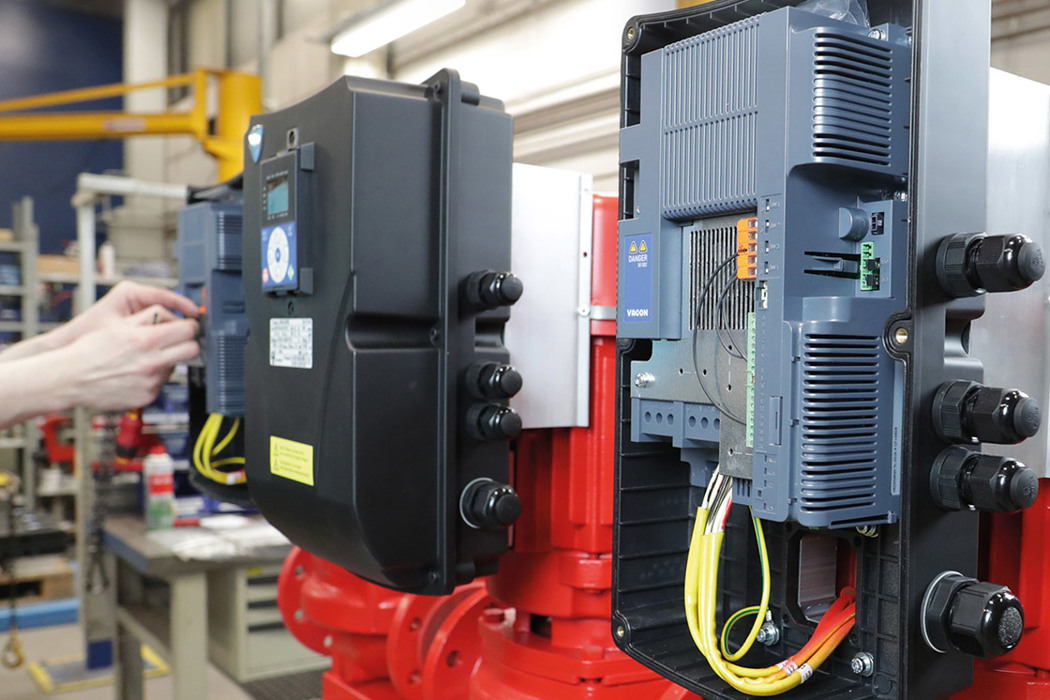In industrial automation, the choice of drive technology can significantly impact performance, efficiency, and operational costs. Understanding the differences between modern Vacon drives and traditional drives is essential for engineers, facility managers, and maintenance professionals who want to optimise machinery and reduce energy consumption.
Understanding Traditional Drives
Traditional drives, often referred to as fixed-speed drives, are mechanical or electromechanical systems that control motor operation with limited flexibility. These drives generally operate at a constant speed, determined by the supply frequency.
Key Characteristics
- Fixed Speed Operation: Traditional drives run at a predetermined speed, requiring additional mechanical components for variable output.
- Mechanical Adjustments: Changes in load or speed often rely on gears, pulleys, or throttling devices, which increase wear and maintenance needs.
- Energy Efficiency: Since the motor runs at full speed regardless of demand, energy wastage is common, especially in applications with fluctuating loads.
- Maintenance Requirements: More moving parts translate into higher maintenance demands and increased downtime.
For industries like pumping, HVAC systems, and conveyors, these limitations can affect productivity and energy bills. Traditional drives have served well for decades, but the evolving demands of industrial efficiency require more sophisticated solutions.
Modern Drive Solutions
Modern drive technology, such as a variable speed drive, enables precise motor control, adapting to load requirements in real time. Unlike traditional drives, these systems can regulate speed, torque, and power with minimal energy loss. This adaptability reduces operational strain and improves the overall lifespan of machinery.
Advantages of Variable Control
- Energy Savings: By adjusting motor speed to actual demand, energy consumption can drop significantly, often by 20-50 per cent.
- Reduced Wear and Tear: Smooth acceleration and deceleration prevent mechanical stress on motors and connected equipment.
- Improved Process Control: High precision control allows for consistent product quality and system reliability.
- Lower Maintenance Costs: Fewer mechanical components reduce the likelihood of breakdowns, and predictive diagnostics can alert operators to potential issues.
Industries including water treatment, manufacturing, and material handling have adopted these systems for their ability to optimise performance while lowering costs.
Why Vacon Drives Stand Out
Vacon drives offer a step beyond standard variable speed systems, combining high efficiency with advanced control algorithms. Designed for complex industrial environments, they integrate seamlessly into existing setups while providing enhanced monitoring and automation capabilities.
Key Features
- Advanced Control: Vacon drives deliver precise torque and speed regulation across a wide range of applications.
- Scalable Design: These drives can be configured for single machines or integrated into large, networked systems.
- Built-in Diagnostics: Real-time monitoring helps detect anomalies before they become critical failures.
- Energy Efficiency: Intelligent algorithms optimise power usage without compromising output.
- Support Services: Manufacturers often provide free consultations, commissioning support, and no-obligation quotes to ensure correct implementation.
The combination of efficiency, durability, and intelligent control makes vacon drives a preferred choice for industries seeking long-term operational savings and reliable performance.
Comparing Efficiency and Performance
When assessing traditional versus Vacon drives, efficiency and operational flexibility are critical. Traditional systems excel in simplicity but fall short in adapting to variable loads. Vacon drives, however, respond dynamically, offering:
- Lower energy costs
- Reduced mechanical wear
- Improved process consistency
- Enhanced monitoring and reporting
This flexibility ensures that machinery operates optimally under all conditions. Businesses can also benefit from reduced carbon footprints and compliance with modern energy regulations.
Implementation Considerations
Adopting Vacon drives requires careful planning. Key factors include load characteristics, integration with existing systems, and operator training. Many suppliers provide complimentary consultations to identify the most suitable configuration, helping UK industries implement these drives without operational disruption.
Practical Tips
- Evaluate current motor loads and cycles
- Identify areas where variable speed control can reduce energy consumption
- Choose a scalable solution that can grow with operational needs
- Ensure staff are trained on monitoring and diagnostics tools
Conclusion
The choice between traditional drives and Vacon drives comes down to performance, efficiency, and long-term cost savings. Traditional drives are straightforward but limited, while Vacon drives offer precise control, energy efficiency, and advanced monitoring. For UK industries seeking to future-proof operations, investing in Vacon technology provides tangible benefits, including lower energy bills, reduced maintenance, and improved process reliability.






